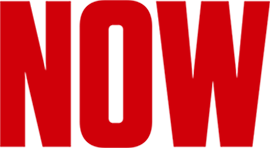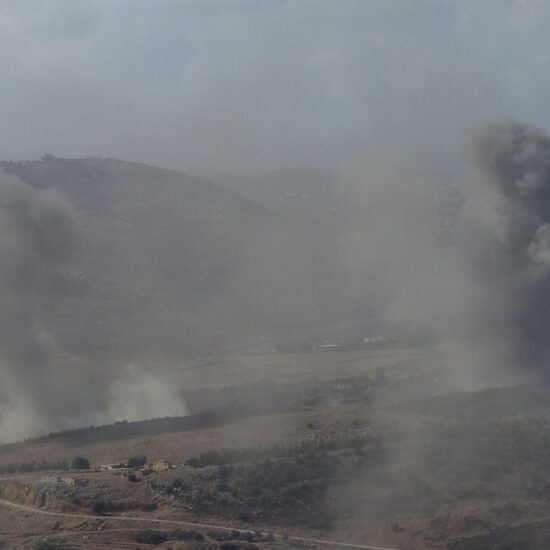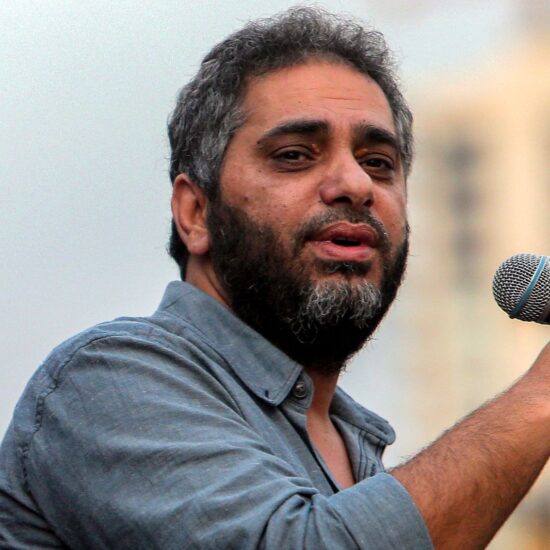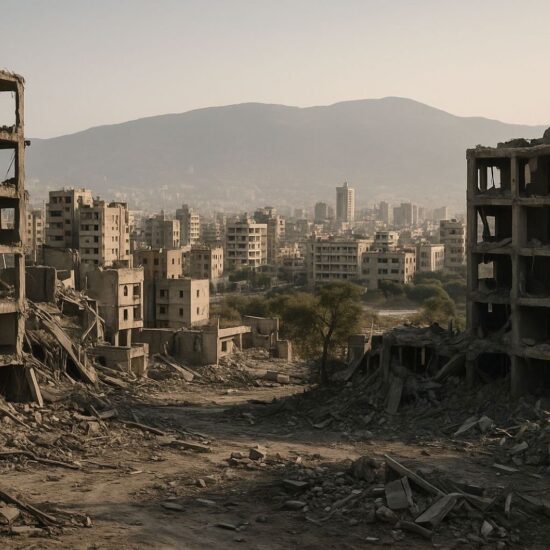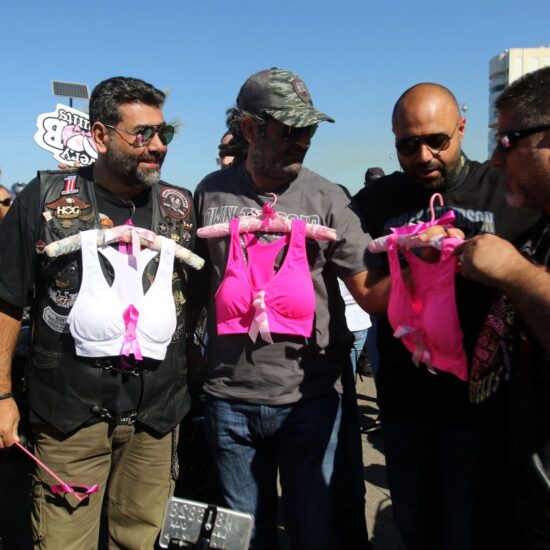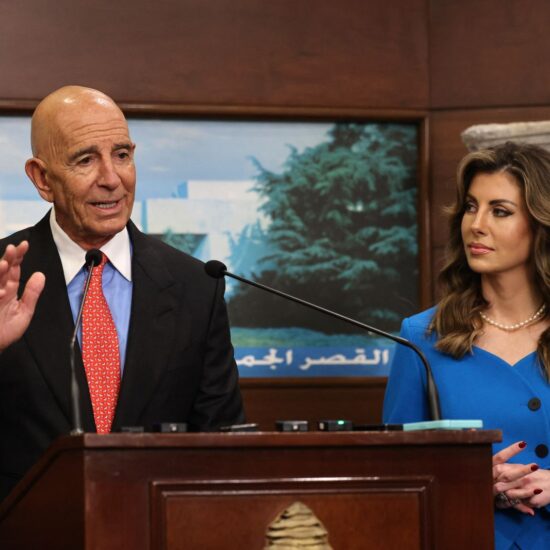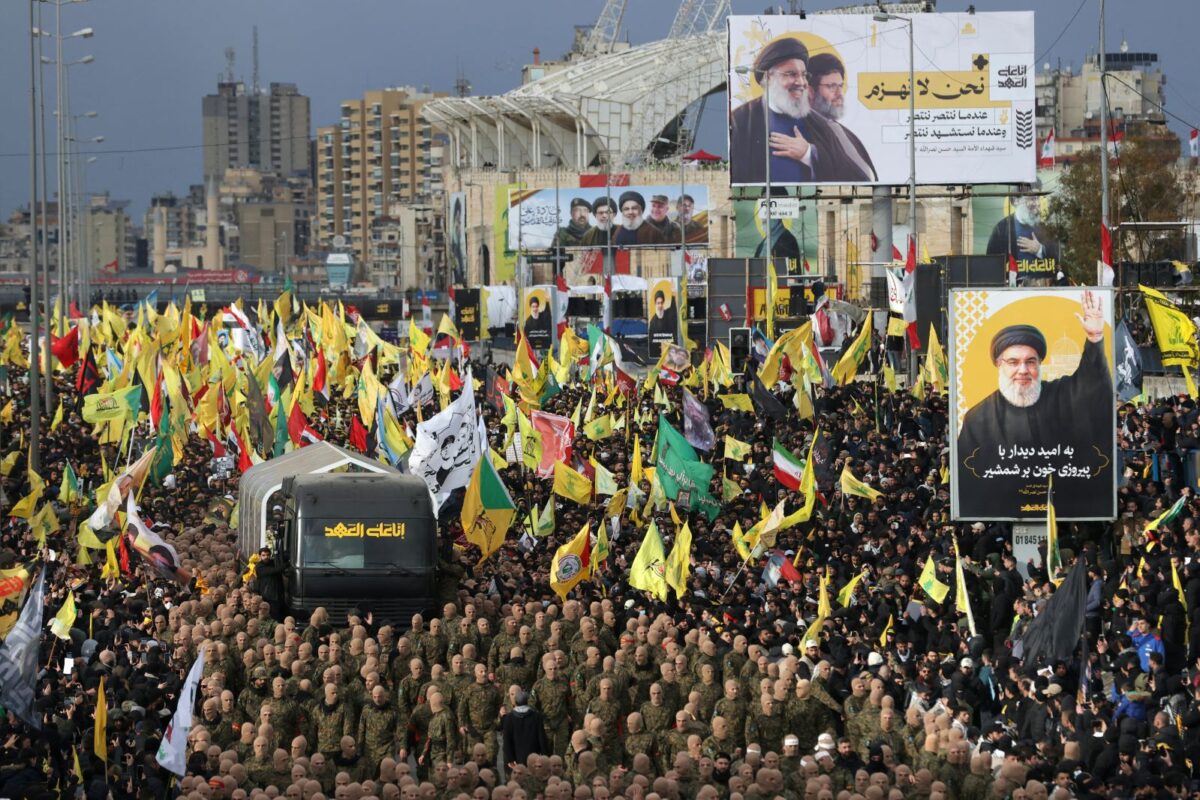
Nasrallah buried amidst a sea of Hezbollah supporters, Israeli aircraft struck border crossings in north Lebanon, while continuing to target the south, Lebanon to exert diplomatic pressure against extended Israeli occupation, Hamas says body believed to be of hostage Shiri Bibas mistakenly mixed with others under rubble, In Gaza, after the sixth exchange of prisoners, fear grows that Israel will resume war soon, Riyadh hosted a summit of eight Arab leaders to discuss an alternative plan to Trump’s proposal for Gaza, IMF delegation visit to Lebanon planned for March, In visit to Tulkarem, Netanyahu calls to expand West Bank operation, Two Palestinian children killed by Israeli army fire in occupied Hebron and Jenin, Syrian foreign minister to visit Iraq, date to be determined, Netanyahu says Israel won’t allow Syrian forces south of Damascus, Syria’s new authorities announced the arrest of several people allegedly involved in weapons trafficking to Hezbollah, Israel threatens to attack Iran’s nuclear program, hoping on Trump’s support, Switzerland repatriated to Lebanon three illegally-stolen artifacts, dating from the 2nd to 3rd century BC, Sudan waterborne disease outbreak kills 24, hospitalises 800, amidst spreading cholera and rising RSF attacks
Eighty-eight days later, the day has come: to reckon with the price of a defeat – although to see it like this, that estimated million of Lebanese, Iraqis, Yemenis, Iranians, even Turks (while internal sources are talking about 1.5 million attendees, others – mainly opponents to Hezbollah – estimate around 750.000), amidst the yellow of waving flags and the blow-up photos of the one who do not even need to be called by his name, other than Sayyedna, ‘our Master’, you would find it hard to believe that they were defeated. What is immediately clear, however, beyond the beheading of the most charismatic – yet divisive – of leaders, beyond the internal political clash, the regional isolation, and even the clear military weakening of the ‘Party of God’, is that for the exhausted, displaced supporters of Hezbollah, Israel has not won the war: because, like it or not, party membership still exists. The party, per se, still exists: albeit on its knees. And the veneration of the leader, now martyred – some, until yesterday, believed that this was not true, that he might turn out to have survived – seems more blind, more absolute than ever.
Hence the collective exaltation, bordering on fanaticism; hence the pride in chanting, the right fists raised to the sky in defiance – ‘death to Israel!’ – at the passage of four Israeli jets, in attack position, as close as they had ever been seen in the skies over Beirut. The affront, the hybris of threatening: if we want, we can start all over again – as the mourning crowd was joined by news of exhumed bombings in the Beqaa Valley and south Lebanon, not far from Deir Qanoun al-Nahr, the hometown of Hashem Safieddine, where the late-cleric – also mourned in Sunday’s ceremony – will be buried today.
Commenting on the Israeli warplanes’ low-altitude flyover of Beirut during Nasrallah’s funerals, the Israeli Army’s Arabic-language spokesperson, Avichay Adraee, stated that it was a “clear and strong message.” He noted that only “Hezbollah and Iranian militia flags” were visible inside Sports City Stadium – where actually a number of Lebanese flags, and a few Palestinian ones, were also visible. Adraee shared his message on X, accompanied by several aerial photos taken during the flyover showing three of the four Israeli fighter jets over Beirut, major roads in the Lebanese capital with parts of the crowd, and the runways of Beirut airport. Only two weeks ago, Adraee had issued a warning regarding Beirut airport, claiming that it was being used to transfer funds from Iran’s Revolutionary Guards to Hezbollah: following this warning, Lebanese authorities indefinitely suspended flights between Tehran and Beirut.
However, among the prominent figures present at the stadium was an Iranian delegation that arrived around 12:30 pm, consisting of over 40 Iranian MPs, led by Iranian Parliament Speaker Mohammad Ghalibaf and Foreign Minister Abbas Araghchi. At the arrival, videos of the just-landed plane were screened in front of the crowd gathered outside Beirut’s Sports City Stadium, welcomed by the Shiite chants Labbaik ya Hussain, ‘we’re here for you, oh Hussain’, while another part of the country – which in divisive matters like this it is not simplistic to define a half – profoundly critic of Hezbollah’s arsenal and its presence in the country, refused to attend the historical event, despite the invitation. Among them, Prime Minister Nawaf Salam and President Joseph Aoun – the latter reported saying “Lebanon is exhausted by the wars of others on its territory” to the Iranian officials touring Beirut. Salam, on the other side, received Iranian Parliament Speaker Bagher Ghalibaf and his accompanying delegation at the Grand Serail at 7 pm, as soon as the delayed burial ceremony ended: it took over an hour to remove Nasrallah’s coffin from the vehicle that transported it to the burial site, due to the dense crowd, with many people wanting to approach the coffin and bless themselves. After the meeting, Ghalibaf, who also met Parliament Speaker Nabih Berri, stated that Iran “supports any decision made by the Lebanese government, people, and resistance in Lebanon.” As if the government, the people, and the resistance, in Lebanon, were unified under a shared will.
And this is what is surprising, beyond the Israeli brazenness, the sovereignty speeches conducted during an air, land, media invasion; beyond the bombings that never ceased, from the day of the expected ceasefire; beyond the permanence of the occupation troops in five positions that they threaten to expand within months – and the impotence of the Lebanese army, whose military planes patrolled the skies over southern Beirut during yesterday’s funerals, and if they could have stopped, dumbfounded, in front of the swift Israeli jets, they would have done so: out of bafflement.
What is surprising, even more profoundly, is the paradox of coexistence, the fact that the death of the most divisive yet charismatic of all leaders, ends up fracturing the Lebanese narratives more in depth than his being alive. So that, while tens of thousands residents of the areas of Tyre began their slow march since Saturday, despite the cold and rain, along the road leading to Beirut’s airport; while Naim Qassem is not hesitant in affirming contradictory sentences as: “we will give diplomacy a chance, and then resistance will reassess,” or: “we will contribute to building a strong Lebanese state under the Ta‘if Agreement, ending the occupation, reconstruction, and implementing an economic rescue plan, committed to ensuring that everyone takes part in building this state,” and even: “we believe in the strength of the army, there are no winners or losers in Lebanon” – the other half of a country that seems never to have been so divided, boycotts the funerals, celebrates the end of an era, toasts to independence, sovereignty, peace. And so busy ensuring that there is no longer any way for Iranian weapons to hold the Lebanese territory hostage, long perceived as the battlefield of others’ proxy wars, it seems not to realise that for once the occupation is ready to be fought by Lebanon as a state – with a regular army, weapons, soldiers representing all sects; and that this enemy, Israel, will be no stranger to keep on using the excuse of terrorism and border defence as a pretext to destroy, siege, and finally annex new territories.
Another border, that of the Syrian Golan, in this context, has been shifting in Israel’s favour – despite the regime change, and the constant reassurances by the new leader, Ahmad al-Sharaa, that he would not attack the Zionist state. It seems not to have been enough. And while Netanyahu prohibits, without any right, the new Syrian army from deploying south of Damascus, Lebanon – the new Lebanon, for the optimist ones – should stay alert, and look at the liberated yet still threatened Syria as the possible prophecy of its own near future: even without Hezbollah.
In Lebanon
They will not leave: Lebanese President Joseph Aoun said the country “unanimously” chose the diplomatic route in response to Israel’s occupation of southern Lebanon past last week’s withdrawal deadline, citing talks with truce monitoring committee members, the US and France alongside a planned appeal to the UN Security Council. The Israeli army said it could extend its occupation by “months,” under the pretext of insufficient measures to root out Hezbollah from the region. Israel plans to remain in Labbouneh-Alma al-Shaab, Jabal Blat, Jal al-Deir, Hammames Hill, and a fifth position along the Merkaba-Houla road – primarily aiming at controlling and dominating vast areas of southern Lebanon through firepower to prevent Hezbollah from rebuilding its military capabilities.
However, the underlying aim is to secure Israel’s freedom of movement to and from these positions. That is true particularly since some of the routes leading to these hills do not pass directly through Israeli territory, which means that parts of Lebanese land will effectively fall under Israeli military control to ensure logistical support and ease of movement for the stationed troops. Moreover, Beirut was informed that Israel will continue carrying out targeted strikes against Hezbollah’s sites and warehouses and will pursue its policy of assassinations targeting its leaders and military officials.
Hezbollah’s leader Naim Qassem, who had threatened Israel with the party’s waning patience for truce violations, had described the withdrawal period as a test for the government – which, in a leaked ministerial statement, omitted overt references to resistance and emphasized a state monopoly on arms.
Death and devastation trails behind: The Lebanese Army redeployed to several villages across Marjayoun and Bint Jbeil, on the heels of the Israeli army’s withdrawal on February 18, clearing the path for returnees who, on arrival, found their homes and livelihoods torn apart. The Civil Defense, meanwhile, announced the recovery of 23 bodies from Mais al-Jabal, Kfar Kila and Odaisseh.
As with other recently evacuated villages, residents found their homes flattened, from wartime strikes or post-truce demolitions – with one Nabatieh resident telling correspondents her home had been destroyed just the day before – or defaced and pillaged by Israeli soldiers who had garrisoned in them during the occupation.
With or without Hezbollah: On Wednesday, February 19, one day after the expected withdrawal of Israeli occupying soldiers from south Lebanon, an Israeli drone strike targeted a car in Aita al-Shaab, killed a man, identified as the son of the town’s municipal chief, and injured his wife. Moreover, two people were injured after Israelis sprayed machine-gun fire on Wazzani, and fired stun grenades near residents gathered in Kfar Kila.
At the same time, as withdrawal partially unfolds, Lebanon’s Civil Defense rescuers recovered the remains of eleven people from the southern Lebanese towns of Mais al-Jabal, Khiam, Markaba and Deir Serian, unreachable in wartime due to unceasing Israeli strikes that repeatedly injured first-aid workers. Rescuers the day before recovered 23 bodies from the area while ongoing searches through Khiam’s rubble have uncovered tens of previously unreported victims of wartime Israeli strikes.
Strike in Wadi Khaled: In the night between Thursday and Friday, Israeli aircraft struck the Syrian-Lebanese border, in northern Lebanon and the Syrian province of Homs, claiming to have targeted illegal border crossings used by Hezbollah to bring in weapons. The strike targeted the Lebanese side of the clandestine crossing of Wadi al-Wawiyat, opposite Wadi Khaled, with several missiles.
Although there have been no casualties so far, the strikes damaged nearby houses and missile fragments hit and overturned a car that was nearby. Shrapnel hit a school close to the railways of Wadi Khaled. One of its walls was hit by the shrapnel, and damage was noted inside.
Similarly, shrapnel and rocks, which were detached due to the force of the explosion, fell on the roof of a house near the crossing point in question on the Lebanese side. Part of the roof collapsed, no injuries were reported in either case, and some cars were damaged.
IMF to visit Lebanon: The International Monetary Fund (IMF) is scheduled to send a delegation to Lebanon in March, Finance Minister Yassine Jaber told Reuters, while an organization representative told AFP of upcoming discussions on “a new aid program that could help restore debt sustainability.”
Lebanon’s new executives have repeatedly prioritized reforms on their agenda. An IMF aid package, allotted in a preliminary agreement of more than $3 billion, has been on hold since May 2022 awaiting the implementation of a host of prerequisite reforms including the unification of the lira-to-dollar exchange rate and interventions into the banking and public electricity sectors.
Artifacts returned: The Lebanese Culture Ministry, represented by the Directorate General of Antiquities (DGA), received three archaeological artifacts from the Swiss embassy in Lebanon that had been illegally removed from the country before being seized by the competent authorities in Switzerland, the state-run National News Agency (NNA) reported on Wednesday. These items include a blue-tinted glass bottle adorned with embossed motifs, a small statue of the goddess Aphrodite dating back to the 2nd-3rd century BC, and a small bronze statuette dating back to the second century BC.
This restitution was made possible through the Ministry of Culture, with Ghassan Salameh being reappointed as its head 22 years after his previous term, along with the DGA and the Lebanese embassy in Switzerland – all reaffirming their determination to continue the fight against the illicit trafficking of antiquities and to work for the restitution of as many archaeological items located outside of Lebanon as possible.
In February 2018, five archaeological items stolen in 1981 from the Byblos citadel’s storerooms, which were located in the United States and Germany, were repatriated to Lebanon; while in September 2021, nine mosaics, a Roman head, and a bronze were recovered from the collection of antique dealer Georges Lotfi.
In The Region
Hostage, mistaken: On Thursday morning, in Khan Younis, southern Gaza, armed fighters displayed four black coffins on a podium, each bearing a photo of one of the hostages killed during Israel’s onslaught on the Strip. Above, a poster showing Benjamin Netanyahu with his face stained with blood, flanked by vampire teeth.
Among them, children Ariel and Kfir Bibas, aged four years and eight and a half months respectively when they were abducted in Israel on October 7, 2023, and their mother Shiri Bibas. The fourth body was that of Oded Lifshitz, who was 83 years old on October 7. Hamas has consistently claimed that the kids and the other hostages died in captivity were killed in Israeli airstrikes during its genocidal war on Gaza.
Israel has accused Hamas of handing over the body of an unknown person instead of that of Shiri Bibas. On Saturday, Bibas’ family confirmed that the remains of Shiri have been returned by Hamas, a day after the announcement that the Palestinian group had returned an unidentified body.
Ahead of the release, Hamas announced its willingness to liberate all the hostages still held in Gaza during a single exchange in the second phase of the cease-fire, due to begin in early March. On Saturday, after receiving six more hostages released by Hamas, Israel was set to release 602 Palestinian prisoners in the sixth exchange under the truce agreement in the Palestinian territory – marking the largest number of Palestinians freed at once under the current truce. Of those to be released, 445 were from Gaza and were arrested after the Hamas attack on October 7, 60 were serving long sentences, 50 life sentences and 47 were rearrested after a prisoner swap in 2011, Amani Sarahneh, spokesperson for the Palestinian Prisoners Club NGO, told AFP. Six of them, however – led by Samer al-Issawi, who holds the record for the lunges hunger strike in prison – refused to be released from detention, rejecting deportation abroad.
The exchange came amid continuing rhetoric calling for the resumption of Israel’s war on the enclave by far-right officials – for which the threat was raised the week before amid a brief hold-up to hostage releases. The second phase of the truce, for which negotiations are still ongoing, was already set to include a total release of hostages, accompanied by Israel’s total military withdrawal from Gaza. It is also set to include ramped-up humanitarian support for Gaza, where Israel’s 15-month-long onslaught killed more than 48,000 people and devastated the enclave. “Children have been killed, starved and frozen to death,” UN official Tom Fletcher said last month, adding: “Some died before their first breath – perishing with their mothers in childbirth.”
Bus bombs, operation West Bank: Israeli Prime Minister Benjamin Netanyahu ordered an intensive operation against the occupied West Bank after a series of explosions detonated on buses on Thursday night in Bat Yam, in the center of the country. The leader “ordered the Israel Defense Forces to conduct an intensive operation against centers of terrorism” in the West Bank, and asked the police and the Shin Bet – Israel’s domestic intelligence – “to increase prevention activity” of such attacks. However, no Palestinian group has claimed responsibility for the attacks yet.
According to the mayor of the town, Tzivka Brot, there were no injuries. Two other devices were defused. Following the explosions, a large police force was deployed to search for suspects, according to the police. Footage broadcast by Israeli television stations showed one bus burned and another on fire. According to Israeli media, bus drivers across the country were asked to stop and inspect their own buses for explosive devices.
An official in the Prime Minister’s office said that Netanyahu called “the planting of explosives on buses a very serious incident and will order decisive action against terrorist elements in the West Bank.” Earlier on Friday, the Israeli army announced the deployment of three additional battalions to the West Bank following Netanyahu’s directive for a “strong operation:” and the first victims did not wait to arrive. Two Palestinian children were in fact already killed by Israeli army gunfire in two separate incidents on Friday, February 21, in the occupied Hebron and Jenin. The first victim was 13-year-old Ayman Nassar al-Himouni, who was fatally shot in the southern West Bank city of Hebron; separately, 13-year-old Rimas Omar Amori was killed by Israeli forces in the Jenin refugee camp, in the northern West Bank.
For the second consecutive month – since the day after the beginning of the truce in the Gaza Strip – the Israeli military has been conducting operations in northern West Bank refugee camps, particularly in Jenin, Tulkarem, and Tubas, resulting in at least 60 fatalities and thousands of displacements. Tension has been running high across the occupied West Bank, where at least 920 Palestinians have been killed and nearly 7,000 others injured in attacks by the Israeli army and illegal settlers since the start of the Gaza war on October 7, 2023, according to the Health Ministry.
Netanyahu in Tulkarem: Denouncing the buses’ attacks, Defense Minister Israel Katz had immediately said that he had ordered an intensification of operations in all the refugee camps in the West Bank, notably that of Tulkarem – where Netanyahu entered, accompanied by soldiers of the army. The Israeli Public Broadcasting Authority KAN shared a photo of Netanyahu inside the home alongside Israeli military officers, outrageously putting an Israeli flag on one of the walls.
“We are destroying entire streets, eliminating militants, and I have instructed reinforcements in the West Bank along with additional military operations,” Netanyahu said in a recorded statement from Tulkarem, released by his office. He added that the military campaign aims to dismantle the infrastructure of Palestinian armed factions.
The Palestinian Foreign Ministry has condemned Israeli Prime Minister Benjamin Netanyahu’s visit to the Tulkarem refugee camp in the occupied West Bank, denouncing it as an “assault” and an “aggression” against the territory. In a statement, the Ministry described the “raid on the refugee camp as a manifestation of Israel’s persistence, as the occupying power, not only in its aggression against the Palestinian people but also in carrying out extrajudicial executions, demolishing homes, and forcibly displacing Palestinians.”
According to available data, Netanyahu’s last publicly announced visit to the West Bank was in September 2024, when he toured the Jordanian border in the eastern part of the territory. In July, the International Court of Justice declared Israel’s long-standing occupation of Palestinian territories illegal, calling for the evacuation of all settlements in the West Bank and East Jerusalem.
The Riyadh summit: Saudi Arabia hosted a summit of eight Arab leaders on Saturday, February 22, to discuss a plan to respond to Donald Trump’s proposal to bring the Gaza Strip under US control and relocate the population of the war-torn Palestinian territory.
Riyadh tried to dampen expectations by announcing a customary “informal fraternal meeting” between the leaders of the six Gulf countries, as well as those of Egypt and Jordan, specifying that its decisions will be on the agenda of the Arab summit scheduled for Egypt on March 4. The meeting was attended by Jordan’s King Abdullah II, Qatar’s Emir Tamim bin Hamad Al Thani, Egyptian President Abdel Fattah al-Sisi and United Arab Emirates President Sheikh Mohammed bin Zayed Al Nahyan. Kuwait’s Emir Mishal Al-Ahmad Al-Jaber Al-Sabah and Bahrain’s Crown Prince Salman bin Hamad Al Khalifa also participated.
The leaders exchanged views on regional and international issues, particularly focusing on the Palestinian cause and the situation in Gaza. Trump has repeatedly called for the US to “take over” Gaza and resettle its population to redevelop the enclave into “the Riviera of the Middle East.” The idea has been vehemently rejected by the Arab world and many other nations, who say it amounts to ethnic cleansing.
Syria’s foreign relations, resumed: Syrian Foreign Minister Assaad al-Chaibani has received an invitation to visit Iraq, with the date to be determined following “necessary technical consultations,” Syria’s state news agency SANA reported, as cited by Reuters. Two Iraqi sources had earlier told Reuters that Chaibani was expected to make an official visit to Baghdad on Saturday. The agency said the visit would address issues of mutual interest and seek to open a new chapter in bilateral relations following the overthrow of Assad.
At the same time, Iran’s Deputy Foreign Minister Majid Takht-Ravanchi stated on Thursday that Tehran is ready to establish “friendly” relations with the new Syrian administration, affirming its respect for the Syrian people’s decision once a new government is formed. These remarks follow the Qatari Emir’s visit to Iran, during which the latter urged Tehran to support Syria’s stabilization during the transition.
Israel threatens Syria: Meanwhile, Israeli Prime Minister Benjamin Netanyahu stated Israel will not allow Syria’s new army or the insurgent group that led the ouster of former President Bashar Assad to “enter the area south of Damascus” as his government made clear Israeli forces would stay in parts of southern Syria for an indefinite period.
Netanyahu’s comments Sunday at a military graduation led to new concerns over the Israeli presence, and sway, in a swath of southern Syria as Damascus’ new leaders attempt to consolidate control after years of civil war.
“Take note: We will not allow HTS forces or the new Syrian army to enter the area south of Damascus,” Netanyahu said, referring to Syria’s new authorities as well as Hayat Tahrir al-Sham, the main former rebel group. “We demand the complete demilitarization of southern Syria in the provinces of Quneitra, Daraa and Suwayda from the forces of the new regime. Likewise, we will not tolerate any threat to the Druze community in southern Syria.”
There was no immediate response from Syrian authorities. Defense Minister Israel Katz added that Israeli forces will remain on the peak of Mount Hermon in southern Syria and in a buffer zone “for an indefinite period of time to protect our communities and thwart any threat.”
The outcomes of a long war: An explosion in a house in al-Nayrab, Idlib countryside, killed six people, including two children, and severely injured a young girl. Initial investigations suggest the blast was caused by stored munitions. The incident highlights the dangers of unexploded ordnance and unsafe munitions storage in civilian areas. Handicap International warns that between 100,000 and 300,000 unexploded ordnances pose a threat to millions of Syrians.
Also, a UNDP report revealed that the war in Syria has caused over $120 billion in economic losses and a 50% decline in GDP, with 90% of Syrians now living below the poverty line amid widespread infrastructure damage and deteriorating basic services. This highlights the war’s devastating impact on Syria’s economy and living conditions, emphasizing the urgent need for international intervention to support recovery and humanitarian relief.
In this regard, UN Envoy Geir Pedersen stated on Friday that forming an inclusive Syrian government could facilitate sanctions relief, emphasizing that genuine political consensus may improve economic and living conditions.
Across borders: The Syrian General Security arrested several groups involved in the “trafficking and sale of arms to Hezbollah” on Wednesday, in the Qutayfah region, a suburb of Damascus, according to the Syrian news agency Sana. The arrests took place after “a surveillance and investigation operation,” according to the governorate of the Damascus suburb, as cited by Sana. An image published by the agency shows a truck filled with several dozen pieces of ammunition resembling artillery shells.
The Qutayfah region faces the Baalbeck region on the Lebanese side. The Lebanese Army had closed several illegal crossing points in the area over the weekend, particularly at Hosh al-Sayyed Ali, Qasr and Qaa.
Since the regime’s overthrow on December 8, the new Syrian authorities, composed mainly of Hay‘at Tahrir al-Sham (HTS), have been striving to thwart any smuggling attempts between Lebanon and Syria. They launched an operation on February 6 against families allegedly close to Hezbollah in Hermel, near the Lebanese border, accused of engaging in smuggling activities. Violent and deadly clashes continued for several days before the Lebanese Army fully deployed, following discussions between interim Syrian President Ahmad al-Sharaa and Lebanese President Joseph Aoun to end the fighting. A month earlier, on January 17, security forces in Tartous, north of Lebanon, foiled an arms trafficking operation, while Syrian authorities had begun closing illegal crossings along the Syrian banks of the al-Kabir River near Lebanon’s northern border.
Israel and the Islamic Republic, a confrontation: “You cannot threaten Iran on one hand and claim to support dialogue on the other hand,” Iran’s Foreign Ministry spokesman Esmaeil Baghaei said on Monday, speaking at a weekly press conference. “When it comes to a country like Iran, they cannot do a damn thing.” The comments came after Israeli Prime Minister Benjamin Netanyahu met US Secretary of State Marco Rubio in Jerusalem on Sunday and said their countries were determined to thwart Iran’s nuclear ambitions and its influence in the Middle East.
According to US intelligence reports from early January, Israeli officials plan to target Iran’s two main nuclear sites in the coming months – the Natanz underground enrichment plant and the Fordo enrichment site, both south of Tehran. Iran’s nuclear issue, which is Israel’s main security concern – as the Islamic Republic is aiming at enriching uranium to up to 60 percent – was at the top of the agenda when Netanyahu met Trump in Washington at the beginning of the month, on February 4.
On Sunday, on the sidelines of US Secretary of State Marco Rubio’s visit to Tel Aviv, Netanyahu vowed to “finish the job” against Iran. Tel Aviv is increasingly appealing to its American ally to obtain its much-needed support in striking Tehran and its nuclear program.
However, having promised to bring ‘peace’ to the Middle East during his second term, Trump wants to do everything he can to avoid involving his country in a direct confrontation with Iran. “Everyone thinks Israel, with our help or our approval, will go in and bomb the hell out of them. I would prefer that not happen. I’d much rather see a deal with Iran where we can do a deal, supervise, check it, inspect it,” Trump told Fox News on Monday, while CNN reported that Saudi Arabia is open to mediation between Washington and Tehran.
But for Tel Aviv, the time to strike seems more opportune than ever. While the strength of Hezbollah, the crown jewel of the Iran-led ‘Axis of Resistance’, has been sapped by the Israeli army, the weakening of Hamas in Gaza and the fall of Bashar al-Assad’s regime in Syria have largely furthered Iran’s isolation on the regional scene. All the more so since the Israeli attack on Iran at the end of October 2024, after it fired 200 ballistic missiles against Israel, has already succeeded in degrading Tehran’s air defense and missile production capabilities.
Sudan without clean water: An out-of-control waterborne disease outbreak in southern Sudan has killed at least two dozen and left more than 800 others in hospital over the past three days, Doctors Without Borders (MSF) said on Friday. The outbreak in White Nile state followed a reported drone strike on the Um Dabakar power station – 275 kilometres south of the capital Khartoum – which disrupted access to clean water in the city of Kosti.
Sudanese health officials said Thursday that over 400 cases of cholera had been already detected in the city. The surge in cases was attributed to a “shortage of water due to power outages,” the Health Ministry in White Nile state said in a statement. It comes with Sudan’s healthcare system crippled by the country’s brutal civil war which has killed tens of thousands and displaced more than 12 million people since April 2023.
“The most likely source of infection is the river, where many families have been collecting water using donkey carts after a major power outage in the area,” the medical charity MSF said in a statement. Officials have since banned the practice and urged stronger chlorination of the water distribution system. Most local restaurants and Kosti’s market have closed as a precaution.
Sudan declared a cholera epidemic last year, with nearly 25,000 cases and 699 deaths recorded by October, according to government data. The World Health Organization (WHO) warns that cholera can kill within hours if untreated, though most cases can be managed with oral rehydration and antibiotics.
The International Committee of the Red Cross last month highlighted a “disturbing pattern of attacks” on civilian infrastructure, including power stations, further worsening living conditions for millions already affected by the conflict. In addition, the White Nile state, which stretches from south of Khartoum to the South Sudanese border, has seen escalating violence this week. A three-day RSF (Rapid Support Forces) assault on villages about 200 kilometres north of Kosti killed more than 200 people earlier last week.
What We’re Reading
Financial lifelines and Kabala finance: According to Maan Barazy, Hezbollah’s recent protests on Airport Road, sparked by the decision to prevent an Iranian flight from landing at Beirut’s Rafic Hariri International Airport, appear to be a strategic move to secure the flow of capital and fresh funds to the organization. By rallying their supporters and creating a spectacle, Hezbollah aims to send a strong message to both their adversaries and potential benefactors, emphasizing their resilience and capability to mobilize resources despite external pressures.
The war of narratives: Recent developments – such as the Lebanese Army’s enforcement of security measures at the airport and its prevention of an Iranian aircraft from landing – have effectively curtailed some of Hezbollah’s privileges and sparked a new phase in this narrative war, Khalil Gebara commented. Hezbollah now claims that these actions are attempts to block Iranian financial aid intended to compensate families affected by the recent conflict.
USAID funds suspended: Trump’s decision to temporarily suspend global aid has worldwide implications, affecting all recipient countries, UN agencies, and international and local organizations funded by USAID, including Lebanon, Rodayna Raydan reported.
A ceasefire, a government, a funeral, an unwritten future: Lebanon is caught in a moment of transformation; everything is in motion, yet nothing is truly defined. Over the past few months, Ramzi Abou Ismail wrote, a series of high-stakes political developments have unfolded, each carrying the weight of historical significance, yet leaving behind more questions than answers.
The day after has come: In a Syria where politics had been slowly assassinated, the tireless efforts of bringing it back to life are giving their fruits. Valeria Rando conducted a long conversation with Dr. Najib Ghadban on return, darkness, the staticity of time, and the longest exile.

